Abstract
This study investigates Spanish-language public discourse on YouTube following the unprecedented Iberian Peninsula blackout of 28 April 2025. Leveraging comments extracted via the YouTube Data API and analyzed with the OpenAI GPT-4o-mini model, it systematically examined 76,398 comments from 360 of the most relevant videos posted on the day of the event. The analysis explored emotional responses, sentiment trends, misinformation prevalence, civic engagement, and attributions of blame within the immediate aftermath of the blackout. The results reveal a discourse dominated by negativity and anger, with 43% of comments classified as angry and an overall negative sentiment trend. Misinformation was pervasive, present in 46% of comments, with most falsehoods going unchallenged. The majority of users attributed the blackout to government or political failures rather than technical causes, reflecting a profound distrust in institutions. Notably, while one in five comments included a call to action, only a minority offered constructive solutions, focusing mainly on infrastructure and energy reform. These findings highlight the crucial role of multilingual, real-time crisis communication and the unique information needs of Spanish-speaking populations during emergencies. By illuminating how rumors, emotions, and calls for accountability manifest in digital spaces, this study contributes to the literature on crisis informatics, digital resilience, and inclusive sustainability policy.
1. Introduction
Effective communication is crucial during disasters, as affected populations urgently seek accurate, timely information and guidance. Decades of research in disaster communication emphasize that individuals will use any available media to meet their information needs during crises [1]. In recent years, social media in particular has emerged as a vital channel for crisis communication. Survivors and observers use platforms such as X (previously Twitter), Facebook, YouTube and others to share eyewitness reports, provide aid, and find news in near real time. Indeed, classical studies of crisis informatics show that peer-to-peer social media messages often reach affected people faster and with more local detail than official sources [2]. Surveys bear this out: for example, one study found that 43% of European citizens used social media for emergency information, and 58% said they would do so in future incidents [3]. Citizens increasingly expect crisis updates from both traditional and online sources. As a result, guidelines for crisis managers advise monitoring social platforms continuously to meet public expectations and to counter misinformation promptly [4].
At the same time, the openness of social media means that unverified rumors and false explanations can spread rapidly. Researchers have documented that, during emergencies, people not only exchange facts but also vent anxieties and circulate speculation on these platforms [5]. Official reports note that “rumors, misinformation and false information on social media proliferate before, during and after disasters and emergencies” [6]. Such content can have serious consequences: studies show misinformation tends to generate fear and confusion, erode social trust, and delay effective response. For example, misleading online posts in past disasters have been linked to heightened public anxiety and slowed rescue efforts [7]. During crises, false information can lead to heightened anxiety, fear, and poor decision-making, undermining community preparedness and resilience [5,8]. In recognition of this, emergency management best practices stress addressing rumors quickly and engaging with public concerns to maintain trust [4].
On 28 April 2025, the Iberian Peninsula experienced an unprecedented power failure. A massive blackout swept across Spain and most of Portugal, affecting nearly 60 million people [9,10]. Officials characterized the event as one of Europe’s largest-ever outages. Power was lost virtually everywhere on the peninsula, plunging cities and towns into darkness for several hours. Commuters were stranded (trains halted, elevators stalled) and residents lost phone and internet service as traffic lights went out and daily life ground to a halt. Most power was restored by the following day, but by early 29 April, about 90% of Spain and Portugal’s grids still remained offline. Crucially, no definitive cause has been identified. Early speculation ranged from unusual atmospheric phenomena to equipment failures, but initial statements proved inconsistent. The Portuguese government suggested “an unexplained power transmission issue” possibly originating in Spain, while Spanish authorities reported a loss of connection to France. Both governments cautioned against making premature conclusions. Spain’s Prime Minister explicitly warned the public not to spread unverified theories in order to avoid misinformation. Thus, the blackout’s extent and impacts were clear, but its origins remained shrouded in uncertainty—a situation ripe for public speculation online.
Given these circumstances, analyzing online discourse provides valuable insights. YouTube is an especially relevant venue. In many countries, YouTube is among the leading sources of news and commentary. For example, Pew Research reports that roughly one-quarter of U.S. adults regularly use YouTube for news [11]. In the Spanish-speaking world, YouTube is similarly pervasive for informational content. Crucially, news and analysis videos on YouTube often attract active comment threads where viewers post reactions and theories. Prior work has pointed out that YouTube’s comment culture is an “alternate public sphere” in which users debate and label information as (mis)information [12]. Analyzing comments can therefore reveal how viewers interpret events and evaluate competing narratives. In crises, this immediate feedback loop may amplify rumors or help correct them. To date, much social media research in disasters has focused on text-based platforms like X (previously Twitter), but video platforms merit attention too. The present study examines the most relevant Spanish-language YouTube videos posted on 28 April 2025 that relate to the blackout. By collecting and analyzing their comments, it aims to capture the first wave of public interpretation: What causes do users speculate? What emotions and concerns are expressed? Does misinformation about the outage circulate?
Focusing on native Spanish discourse addresses an important research gap. Most disaster communication studies to date have centered on English-language content and audiences. Global crises such as the COVID-19 pandemic have highlighted the problems of English-centric messaging: linguistic minorities can be effectively excluded from timely, trusted information [13]. Spanish-language media outlets play a critical role in warning and educating Hispanic populations, suggesting that non-English speakers have distinct information channels and needs [14]. By systematically examining comments posted on Spanish-language videos on a major blackout, this study enriches the disaster communication literature with insights from a large but under-studied population.
Understanding these YouTube discussions has practical significance. First, it informs emergency communication strategies for the Iberian region and similar settings. Identifying common myths or unfounded claims about the blackout allows authorities and media to target clarifying messages. For instance, if many commenters blame cyberattacks or terrorism for the outage, officials could pre-emptively address those rumors. Second, this analysis contributes to combating misinformation more broadly: by revealing how and why falsehoods spread in Spanish online communities, communicators can design better literacy campaigns and correction strategies. Finally, gauging public sentiment and trust via comments can help gauge resilience. Insights into emotional responses (e.g., anger, fear, or humor) and trust in information sources can guide how future alerts are phrased and disseminated.
2. Methods
This study analyzed Spanish-language public discourse on YouTube related to the Iberian Peninsula blackout that occurred on 28 April 2025. Comments were extracted using the YouTube Data API v3, focusing on videos uploaded on the day of the blackout and most relevant to the search query “apagón” (Spanish for “blackout”). This approach ensured the relevance of the collected data to the event in question. A total of 76,398 comments from 360 videos were retrieved on 16 May 2025, providing a substantial dataset for analysis.
The extracted comments were processed and analyzed using Python 3.12. The OpenAI GPT-4o-mini model, accessed via the OpenAI API, was employed to perform various analyses on the dataset. GPT-4o-mini is a cost-effective and efficient language model suitable for tasks requiring natural language understanding and generation.
The analyses conducted included the following:
- Sentiment analysis: Assessing the polarity (positive, negative, and neutral) of comments to gauge public sentiment.
- Emotion detection: Identifying specific emotions expressed in comments, such as anger, joy, fear, and sadness.
- Misinformation identification: Detecting comments containing false or misleading information.
- Civic engagement indicators: Recognizing calls to action, expressions of trust or distrust in institutions, and other forms of civic participation.
The use of GPT-4o-mini facilitated the efficient processing of large volumes of text data, enabling nuanced insights into public reactions during the blackout.
Several limitations should be acknowledged. This study focuses solely on YouTube comments, which may not represent the broader public opinion. Users who comment on YouTube might differ demographically or behaviorally from the general population. Only comments to Spanish-language videos were analyzed. Consequently, perspectives expressed in other languages were not included. While GPT-4o-mini is proficient in natural language tasks, it may not perfectly interpret sarcasm, idioms, or context-specific nuances, potentially affecting the accuracy of sentiment and emotion analyses. The data reflect sentiments and opinions at a specific point in time (collected on 16 May 2025). Public opinion may have evolved since then, and the findings may not capture longer-term shifts in perception. Identifying misinformation relies on the model’s training data and current knowledge base. Emerging false narratives or context-specific misinformation might not be accurately detected. Despite these limitations, the methodology provides valuable insights into public discourse during the blackout and demonstrates the utility of combining API-based data extraction with advanced language models for social media analysis.
In addition to the methodological limitations outlined above, ethical considerations play a crucial role in the analysis of public crisis discourse. Although only anonymized, publicly available comments were examined, the process of labeling misinformation and classifying user sentiment carries inherent ethical challenges. Automated classification tools may inadvertently mislabel statements, especially in emotionally charged or ambiguous contexts, which could contribute to the stigmatization of certain groups or perspectives. Furthermore, crisis events often involve vulnerable populations who may be disproportionately affected by the circulation of misinformation or by having their voices misrepresented or misunderstood in data-driven studies. Researchers should remain sensitive to these ethical dilemmas, striving to balance the societal benefits of timely crisis insights with the imperative to minimize potential harms to vulnerable communities.
3. Results
A total of 76,398 comments were extracted on 16 May 2025 from 360 videos identified as the most relevant results for the search query “apagón”, referring to videos published on 28 April 2025. Most comments received little to no engagement in terms of likes and replies. The like count has a mean of 3.07 and a median of 0, indicating that while a few comments received high numbers of likes (up to 3293), the majority received none. The 75th percentile is just 1, confirming that 75% of comments have one like or fewer. The reply count also shows minimal interaction, with a mean of 0.28 and a median of 0, suggesting that most comments received no replies. The maximum of 287 replies reflects the presence of a small number of highly engaged comments.
3.1. Emotional and Sentiment Analysis
The emotion distribution in the comments (see Figure 1) reveals a predominance of negative sentiments, with anger being the most prevalent emotion at 43.21%. This is followed by joy at 23.92%, indicating a substantial yet secondary presence of positive emotion. A notable portion of the comments, 10.90%, falls under the unknown category, suggesting limitations in emotion detection or ambiguous expressions. Other emotions such as fear (7.46%), surprise (6.01%), and sadness (5.80%) are also present, reflecting a mix of emotional responses. Less frequently observed are disgust (1.26%) and neutral (1.12%) tones. Remaining emotions, which comprise 0.32%, are labeled as other.
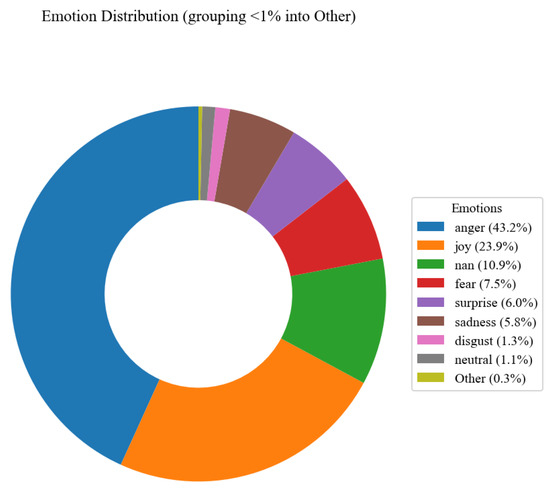
Figure 1.
Emotion distribution in comments.
The sentiment score analysis (see Figure 2) indicates an overall negative tone in the comments. The mean sentiment score is −0.274, and the median is even lower at −0.600, suggesting that more than half of the comments lean significantly negative. The standard deviation of 0.592 reflects a moderate spread in sentiment values. A skewness of 0.729 points to a right-skewed distribution, meaning that while most comments are negative, there are some more positive outliers. The kurtosis of −1.206 indicates a flatter distribution than a normal curve, with fewer extreme values and a broader spread around the mean.
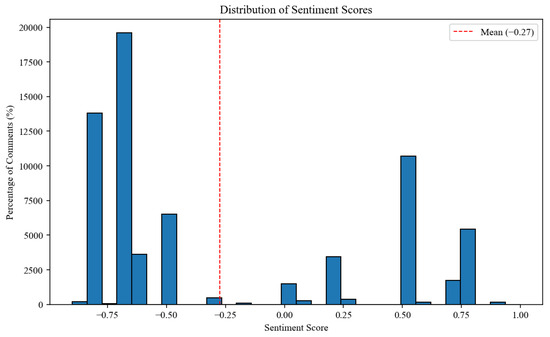
Figure 2.
Distribution of sentiment scores.
The sentiment trend over time reveals a temporary improvement in the overall tone of comments, followed by a return to negativity (see Figure 3). From 28 April (−0.203) to 7 May (0.077), sentiment scores gradually shifted into positive territory, suggesting a short-lived period of optimism or reduced negativity. However, this trend reversed after 7 May, with sentiment steadily declining to −0.206 by 16 May. Despite these fluctuations, the net change over the entire period is minimal (−0.003), indicating that the overall sentiment remained consistently negative, with only a brief interruption in tone.
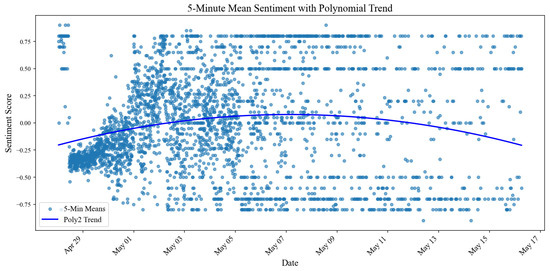
Figure 3.
Sentiment changes over time.
3.2. Political, Personal, and Civic Dimensions
The political leaning distribution of comments indicates a predominantly neutral stance, with 58.4% of comments not expressing clear political alignment. A significant portion, 24.7%, reflects a left-leaning perspective, while right-leaning comments make up a small minority at 3.4%. Additionally, 13.5% of the comments could not be classified, falling under the unknown category.
The presence of personal experience in the comments is notable, with 39.7% of users referring to their own experiences. This indicates a significant level of personal engagement and relatability with the topic. However, the majority (60.3%) of comments do not include personal narratives, suggesting that many users prefer to express opinions, observations, or general commentary rather than share direct experiences.
Among the comments that include a call to action (20.3% of all comments), the most common appeal is to demand accountability or protest, accounting for 28.6%, reflecting strong public frustration and a desire for institutional responsibility (see Figure 4). This is followed by calls to improve infrastructure or services (19.0%) and political change or leadership reform (15.4%), indicating a clear focus on both systemic failures and political dissatisfaction. Other frequently mentioned categories include requests for information or transparency (9.4%) and preparedness or emergency planning (6.6%), showing a mix of reactive and proactive concerns. Less common but still present are calls for community support or solidarity (4.3%), financial advice or economic measures (3.0%), and religious or spiritual appeals (2.5%). A small portion (2.2%) encourage the public to stay calm or avoid panic, while 9.0% fall under other, capturing varied or ambiguous actions.
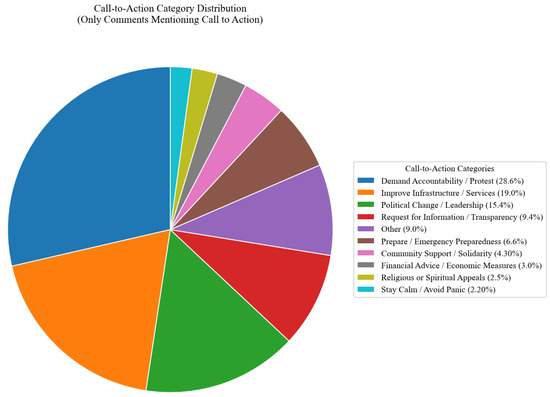
Figure 4.
Call-to-action categories.
The urgency distribution in the comments reveals a balanced yet notable sense of immediacy. About 33.2% of comments convey high urgency, indicating that a significant portion of users perceive the situation as critical and requiring immediate attention. Low urgency comments are nearly as common at 32.4%, suggesting a more restrained or long-term concern. Medium urgency appears in 22.4% of comments, reflecting a moderate level of concern or a call for timely but not immediate action. Lastly, 12.1% of comments could not be clearly classified, falling under unknown urgency.
The tone distribution of the comments is overwhelmingly informal, accounting for 66.1% of all entries. This suggests that most users engage in a casual, conversational style, likely reflecting spontaneous or emotionally charged reactions. Neutral tone appears in 20.4% of comments, indicating a smaller but notable share of objective or matter-of-fact communication. Sarcastic tone is present in 4.4% of comments, often used to express criticism or frustration indirectly. Only 1.5% of comments are formal, underscoring that formal discourse is rare in this context. An additional 7.6% could not be clearly categorized.
The severity descriptions in the comments indicate that most users perceive the issue as serious, with 43.6% labeling it as major. Only 10.3% describe the situation as minor, while a very small fraction (0.2%) considers it critical, suggesting that extreme alarm is rare. Notably, 45.9% of comments fall under the unknown category, either due to vague language or a lack of direct severity assessment.
Mentions of a government response appear in 18.3% of comments, indicating that nearly one in five users explicitly refer to how authorities have acted or failed to act in addressing the issue. This suggests a notable focus on institutional accountability and expectations for official intervention. In contrast, references to a community response are far less common, occurring in only 3.1% of comments. This indicates that public discourse is heavily centered on government responsibility, with relatively little attention given to grassroots or local collective action.
Only 10.1% of comments offer a solution, indicating that the vast majority (89.9%) focus on expressing opinions, emotions, or identifying problems without suggesting a way forward. Among the comments that offer solutions (see Figure 5), the most common suggestions focus on infrastructure and maintenance (30.2%), highlighting a strong demand for improvements to physical systems and long-term reliability. Energy solutions follow at 23.0%, reflecting calls for alternative energy sources or better energy management. Political and governance actions account for 13.1%, showing that some users advocate for institutional reform or policy intervention. Preparedness and self-sufficiency (12.2%) suggest that a portion of users emphasize individual or community resilience. Other solution types include technological and cybersecurity measures (3.6%), economic and market adaptation (2.9%), and social and community support (2.7%), each representing smaller but still meaningful segments. Other solutions make up 12.3%, capturing suggestions that do not fit neatly into a single category.
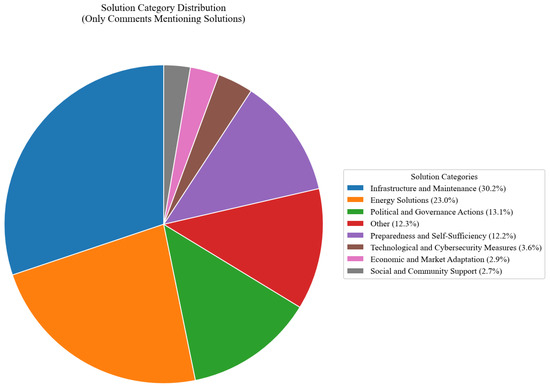
Figure 5.
Solution categories.
Out of all comments, 53.8% include a perceived cause, indicating that over half of users explicitly attributed the event to a specific origin. Among these (see Figure 6), the most common attribution is to government and political failure at 43.9%, reflecting a widespread perception of institutional blame and dissatisfaction with leadership or policy. Infrastructure and technical failures are cited in 21.9% of these comments pointing to concerns about the reliability and maintenance of systems. Other notable categories include conspiratorial or elite manipulation (8.8%), societal or ideological explanations (7.2%), and external attacks or threats (7.0%), revealing a mix of speculative and security-related interpretations. Less frequently mentioned are misinformation or media blame (3.6%) and natural or environmental causes (3.0%), while other causes make up 4.6%.
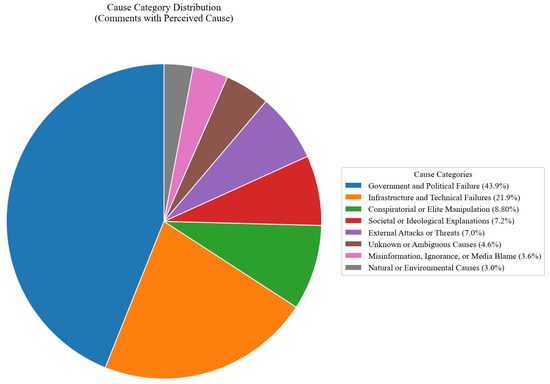
Figure 6.
Cause categories.
Among all comments, 46.1% are flagged as containing misinformation, indicating that nearly half of the discourse includes or engages with misleading or false content (to assess the validity of GPT-4o-mini’s classifications, 100 comments flagged as misinformation-related were randomly selected and manually reviewed. Of these, 86 were clearly identifiable as misinformation, while the remaining comments included context-dependent cases and some apparent false positives. Given the large volume of data, full manual classification was not feasible, and the study relied primarily on the model’s automated identification). The most prevalent type (see Figure 7) is false or misleading claims (40.6%), followed by conspiracy theories (20.0%) and political/ideological misinformation (17.5%), highlighting the dominance of narratives rooted in distortion, speculation, and politically charged content. Additional categories include rumors and speculation (10.5%) as well as bias and distortion (4.0%). Disinformation and manipulation, scientific misconceptions, inaccuracies, denialism, and satire/humor have lower shares. Most misinformation-labeled comments support the false or misleading content (70.8%), while 24.6% take a neutral stance without clear agreement or opposition (see Figure 8). Only 4.6% explicitly oppose it.
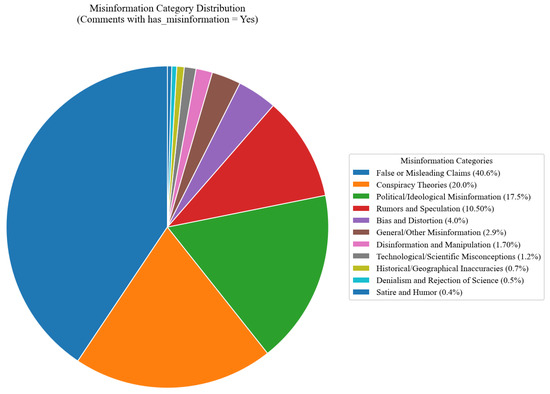
Figure 7.
Misinformation categories.
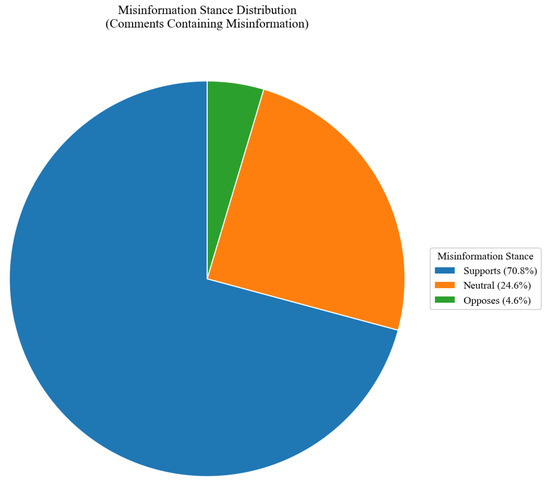
Figure 8.
Misinformation stance.
Among the comments that discuss economic impact (7.4%), nearly half (47.9%) focus on business and commercial losses, emphasizing concerns about disruptions to operations, lost revenue, and economic activity (see Figure 9). Personal and household financial impacts are the second most common theme (16.2%), highlighting the strain on individuals and families. Other notable categories include market and price effects (7.5%), such as inflation or supply shortages, and macro-economic crisis or collapse (4.6%), reflecting broader economic fears. Smaller proportions of comments mention financial system and banking issues (3.1%), asset and property losses (2.2%), and even positive or beneficial outcomes (2.8%), suggesting that a few users perceived potential advantages or long-term improvements. An additional 15.7% fall into the other category, capturing economic concerns that are not clearly classifiable.
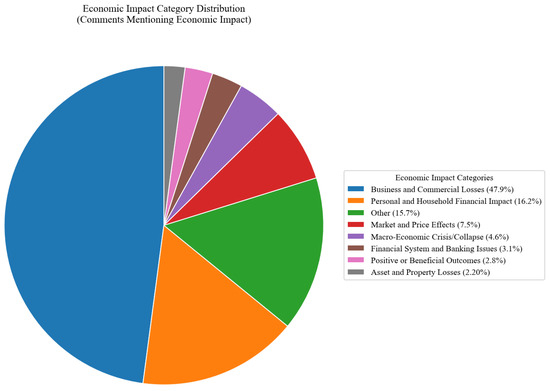
Figure 9.
Economic impact categories.
Out of all comments, 23.6% mention a specific infrastructure impact, highlighting that nearly one in four users engaged with the topic in terms of disrupted systems or services. Most of these references (69.6%) concern electricity and power, reflecting the central role of power outages in public discourse (see Figure 10). Other infrastructure categories are mentioned far less frequently, including telecommunications and internet (7.1%), transportation and mobility (3.9%), residential and public services (2.8%), healthcare and medical infrastructure (1.9%), industrial and energy production (1.9%), food and retail infrastructure (1.8%), water supply and management (1.2%), and financial and banking systems (1.1%). An additional 8.7% of mentions fall under other, capturing less clearly defined or miscellaneous infrastructure concerns.
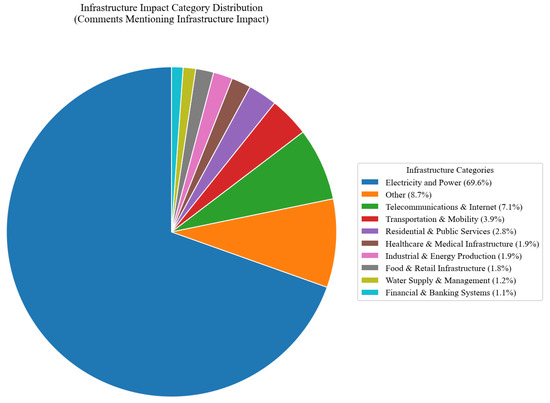
Figure 10.
Infrastructure impact categories.
3.3. Correlation Insights and Statistical Relationships
The analysis of all possible relationships among the studied variables determined several statistically significant findings. A moderate positive correlation was found between like count and reply count (Spearman rho = 0.44, p < 0.001), indicating that posts receiving higher numbers of likes typically attract more replies as well. This suggests a consistent pattern of engagement where popular content is also actively discussed.
Significant associations were also identified for sentiment scores. Regarding political leaning, sentiment varied substantially across groups (ANOVA, p < 0.001). Posts associated with left (−0.70) and right (−0.61) political orientations displayed significantly more negative sentiments compared to neutral ones (−0.10). Similarly, sentiment scores differed sharply depending on the economic impacts described. Positive economic contexts, such as “$18,000 en ganancias”, had distinctly positive sentiment (0.90), whereas severe negative economic descriptions, such as “rise in prices” (−0.90) or “ruina total y extrema miseria” (−0.85), were strongly negative (ANOVA, p < 0.001). Furthermore, posts flagged as urgent exhibited substantially more negative sentiment (−0.73) compared to those of low urgency (0.37), highlighting that urgency aligns closely with negative emotional intensity.
Emotion categories were also clearly linked to sentiment scores (ANOVA, p < 0.001). Negative emotions such as anger (−0.73), sadness (−0.54), disgust (−0.58), and fear (−0.58) corresponded predictably with negative sentiment, whereas positive emotions, including joy (0.61), hope (0.46), and calm (0.25), correlated positively. Additionally, misinformation posts consistently presented significantly more negative sentiment (−0.63) than truthful ones (−0.25), reinforcing the association between misinformation and negative emotional tone (t-test, p < 0.001).
Chi-squared tests revealed particularly strong categorical relationships. Notably, political leaning showed an exceptionally robust association with descriptions of economic impacts (p < 0.001). Likewise, misinformation strongly correlated with the inclusion of calls to action (p < 0.001), indicating that misinformation posts frequently encourage audiences to take specific actions. A similarly strong relationship was observed between the tone of posts and whether solutions were offered (p < 0.001), suggesting a systematic connection between communicative style and the provision of solutions. Furthermore, the presence of personal experience narratives significantly coincided with solution proposals (p < 0.001), highlighting that personal storytelling often accompanies actionable advice.
In examining user engagement more closely, the number of replies differed significantly across types of economic impacts (ANOVA, p < 0.001). Specifically, posts referring to positive economic scenarios received substantially higher average replies (10.50), while severe financial consequences (3.29) also notably stimulated conversation. Similarly, likes varied significantly by economic impact category (ANOVA, p < 0.001), with posts about severe financial consequences (23.12) and loss of access to funds (19.50) attracting particularly high numbers of likes. A weaker yet statistically significant correlation existed between sentiment scores and likes (Spearman rho = 0.03, p < 0.001), suggesting slightly greater popularity for posts with marginally more positive sentiment.
Finally, additional relationships emerged at lower yet still meaningful significance levels. For instance, misinformation content attracted fewer replies on average (0.25) compared to accurate posts (0.40), indicating reduced interactive engagement with misinformation (t-test, p < 0.001).
4. Discussion
Nearly half of all comments (46.1%) were flagged for containing misinformation, a strikingly high proportion that underscores how quickly false narratives can permeate online crisis discourse. The dominant misinformation categories were outright false or misleading claims (40.6%) and conspiracy theories (20.0%). The prevalence of misinformation in Spanish-language forums is especially concerning given evidence that Spanish-speaking audiences may be particularly vulnerable to false narratives [15]. As one recent survey found, Latinos relying on Spanish-language social media were significantly more likely to believe false political stories than those using English-language platforms, suggesting that language-specific misinformation dynamics matter. These findings thus reinforce the need for digital resilience measures that include Spanish-language fact-checking and rapid rumor control. Best-practice guidelines urge emergency authorities to address prominent rumors directly and provide corrective updates promptly [16]. In practice, this means deploying bilingual crisis communication teams or partnering with trusted Spanish-speaking media to debunk falsehoods as they arise. Only 4.6% of misinformation posts were explicitly challenged by other users, indicating a lack of grassroots fact-checking. Proactively engaging Spanish-speaking communities is therefore essential to curb the spread of misinformation and to prevent its harmful effects on public anxiety and decision-making.
The overall sentiment of the YouTube comments was markedly negative. Sentiment analysis yielded a mean score of −0.274 (median −0.600), indicating that more than half of the comments were strongly negative in tone. The only deviation was a brief upward blip: sentiment rose into mildly positive territory by 7 May (+0.077) before declining again to 0.206 by 16 May. This transient optimism likely coincided with initial reports of power restoration, but it quickly evaporated. In line with this, social media studies of other disasters have similarly documented overwhelmingly negative community sentiment in the aftermath of emergencies [17]. They found that after a major flood, the overall sentiment among Chinese microblog users remained negative with multiple peaks and that negative emotions were far more persistent than positive ones.
This pervasive negativity likely reflects public frustration and anxiety. In the analysis, comments flagged as urgent or describing severe impacts (e.g., “extrema miseria”) had the most negative sentiment, whereas posts highlighting any positive outcome (such as “ganancias”) had strongly positive sentiment. This polarity is intuitive: messages about hardship or failure carry much more emotional weight. Notably, comments expressing left- or right-leaning political views were far more negative than neutral comments, suggesting that political polarization intensified negative discourse. In a broader context, such entrenched negativity is worrisome because it can undermine community resilience.
The emotional tenor of the discourse was dominated by anger. In total, 43.2% of comments were classified as angry. Joy was the next most frequent emotion (23.9%), reflecting some expressions of relief or humor. Fear (7.5%) and sadness (5.8%) were relatively rare, as were other emotions. This skew toward anger is consistent with research showing that crises often trigger outrage and blame in social media posts [17,18]. In the present data, angry comments indeed carried strongly negative sentiment, reinforcing how this emotion fueled the overall negativity. Conversely, comments expressing hope or calm (the few positive sentiments) were associated with positive scores. Notably, misinformation posts were significantly more negative (mean −0.63) than truthful posts (−0.25), indicating that emotionally charged users were especially susceptible to false narratives.
Despite the anger, a minority of comments displayed lighter tones. The discourse was overwhelmingly informal (66.1% of comments), often using colloquial or even sarcastic language (4.4% sarcastic). This casual tone suggests that many users were venting spontaneously rather than deliberating. A small fraction of comments (23.9% classified as joy or calm) provided a counterbalance of positivity, perhaps reflecting relief at partial recovery or the sharing of humor to cope. These emotional dynamics highlight how crisis communication must navigate a fraught affective landscape. Sustained anger and low trust can fuel rumor and panic, whereas infrequent positive emotions signal the thin threads of hope.
A substantial fraction of users treated the blackout as a civic issue. One in five comments (20.3%) included an explicit call to action. The most common appeal was for accountability, with 28% of action-oriented comments demanding that authorities explain or rectify the outage. Other calls focused on infrastructure improvements, political change, and requests for information. This high level of public appeals indicates that Spanish-speaking viewers were not merely passive observers but were actively seeking to influence the response. In many ways, this mirrors findings that social media provides a platform for civic expression during disasters [19,20]. The present results reinforce that citizens often use these venues to demand change or assistance [21].
Interestingly, only 10.1% of comments offered concrete solutions or suggestions. Among those, the leading proposals were technical: 30.2% urged infrastructure and maintenance upgrades, and 23.0% called for alternative energy or better energy management. Political/governance reforms (13.1%) and community preparedness (12.2%) were also represented. This distribution shows that when users did propose fixes, they largely envisioned systemic or infrastructural remedies rather than individual actions. The relatively low rate of solution posts suggests that most users were focused on problematizing the situation (through blame and outrage) rather than detailing a way forward.
A recurring theme was skepticism toward authorities. Nearly half of respondents assigned the blackout’s cause to “government and political failure” (43.9%), far exceeding any other explanation. Only 21.9% blamed technical or infrastructure failures, and just 7.0% blamed external threats (e.g., cyberattacks). Moreover, 18.3% of comments explicitly mentioned government response (or lack thereof), whereas only 3.1% referenced community or grassroots action. In short, public discourse was overwhelmingly centered on institutional accountability. This intense focus on government suggests that Spanish-speaking users harbored deep distrust in official explanations and capabilities.
These trust deficits likely stem from both the information vacuum and pre-existing skepticism. Officials had not identified a clear cause, and early statements were inconsistent, creating fertile ground for doubt. Research on crisis communication emphasizes that when uncertainty is high, failure to address rumors quickly can severely erode trust [16]. The present data show that negative sentiment and misinformation were intertwined (misinformation posts had significantly lower sentiment), implying a vicious circle: distrust fuels rumors, and rumors fuel distrust. Conversely, studies like [8] demonstrate that authoritative, trustworthy information can improve sentiment. They found that verified government posts had a positive effect on users during emergencies.
When comparing the present analysis of Spanish-language YouTube discourse during the 2025 Iberian blackout to contemporaneous survey findings, several notable alignments and contrasts emerge. Both this study and the Centre for Sociological Research (CIS) flash survey indicate that a majority of the public experienced significant disruption, with the CIS reporting that 52.4% were significantly or moderately affected [22], while YouTube comments featured widespread references to hardship and urgent need for information. Emotional responses were similarly negative across data sources: the CIS found 21.5% reported fear, especially among younger respondents, while the YouTube analysis revealed a discourse dominated by anger (43.2% of comments) and an overall negative sentiment trend.
A key area of convergence is distrust toward institutions. A survey revealed that nearly 60% considered government communication insufficient, with a demand for more transparency and faster updates. Correspondingly, the YouTube data showed that blame was most often assigned to government or political failures (43.9% of cause attributions in comments), far outweighing technical or accidental explanations, mirroring the 26.6% of survey respondents who suspected deliberate causes like cyberattacks.
Preparedness and civic engagement showed some divergence: the CIS survey found just over half recalled EU emergency kit recommendations, but only a third complied, whereas in YouTube comments, only about one in five included calls to action, and constructive proposals were rare, focusing on infrastructure reform. However, both sources noted that when suggestions were made, they prioritized system modernization and resilience.
These parallels and contrasts emphasize the complementarity of survey and social media data: together, they provide a fuller picture of public sentiment, trust, and vulnerability during the blackout, as well as actionable lessons for crisis communication in diverse, multilingual societies.
5. Policy Recommendations
Based on the analysis of Spanish-language YouTube discourse during the 2025 Iberian Peninsula blackout, several actionable recommendations emerge for those responsible for crisis communication and management in Spanish-speaking communities:
- Monitor Spanish-language social media in real time: Emergency managers should actively monitor platforms like YouTube for Spanish-language discourse during crises to identify emerging rumors, misinformation, and public sentiment.
- Deploy multilingual crisis communication teams: Given the linguistic needs highlighted in this study, authorities should ensure that crisis communication teams are equipped to deliver timely, accurate information in Spanish as well as other relevant languages.
- Partner with trusted Spanish-language media and community leaders: Collaborating with established Spanish-language news outlets and influential community figures can help disseminate corrections and factual updates more effectively, building trust within the community.
- Proactively address rumors and misinformation: Authorities should not only provide official updates but also directly address prevalent rumors, conspiracy theories, and other forms of misinformation as they arise, offering clear evidence-based responses.
- Foster civic engagement and transparency: Communication strategies should go beyond information delivery to engage with public concerns, respond transparently to questions, and encourage constructive civic participation.
- Tailor messaging to platform culture and tone: As the study shows, much of the discourse is informal and emotionally charged. Crisis messages should be crafted to resonate with the tone and style of the target audience, increasing their likelihood of being received and shared.
By implementing these strategies, emergency managers and policymakers can help counter misinformation, build trust, and better meet the unique information needs of Spanish-speaking communities during large-scale crises.
6. Conclusions
This study provides a comprehensive analysis of Spanish-language YouTube discourse during the 2025 Iberian Peninsula blackout, offering new insights into public sentiment, misinformation dynamics, and civic engagement in the context of a large-scale infrastructure crisis. The findings reveal a digital environment characterized by overwhelming negativity, widespread anger, and deep distrust toward political institutions, with misinformation circulating largely unchecked among users. The prevalence of emotionally charged and often inaccurate narratives highlights both the power and the vulnerability of social media as a primary venue for crisis communication, especially for linguistically diverse populations.
Importantly, the analysis demonstrates that while YouTube platforms foster civic participation and calls for accountability, they also facilitate the rapid spread of rumors and conspiracy theories. Only a small fraction of commenters proposed constructive solutions, underscoring the need for targeted, transparent crisis communication and community engagement strategies. The dominance of government-blaming narratives, paired with low institutional trust, suggests that emergency managers and policymakers must not only deliver accurate and timely information in multiple languages but also actively address public concerns and misinformation in real time.
By leveraging advanced language models such as GPT-4o-mini, this research showcases the potential for a rapid, scalable analysis of large-scale social media data. However, it also acknowledges the methodological limitations related to platform bias, language scope, and the challenges of the algorithmic analysis of nuanced human expression. Ultimately, this study contributes to the growing literature on crisis informatics and sustainability, emphasizing the critical importance of inclusive, resilient, and adaptive communication systems to support public trust and effective disaster response in increasingly complex risk environments.
Funding
This research received no external funding.
Institutional Review Board Statement
Ethical review and approval were waived for this study due to the use of fully anonymized data, with no identifiable personal information collected or analyzed.
Informed Consent Statement
Not applicable.
Data Availability Statement
The data used in this study were extracted via YouTube API and analyzed using OpenAI API. Due to platform terms of service and API usage restrictions, the datasets cannot be shared publicly.
Conflicts of Interest
The author declares no conflicts of interest.
References
- Palen, L.; Vieweg, S.; Liu, S.B.; Hughes, A.L. Crisis in a networked world: Features of computer-mediated communication in the April 16, 2007, Virginia Tech event. Soc. Sci. Comput. Rev. 2009, 27, 467–480. [Google Scholar] [CrossRef]
- Petersen, L.; Fallou, L.; Reilly, P.; Serafinelli, E. Public expectations of social media use by critical infrastructure operators in crisis communication. In Proceedings of the 14th ISCRAM Conference, Albi, France, 21–24 May 2017; Available online: https://idl.iscram.org/files/laurapetersen/2017/2040_LauraPetersen_etal2017.pdf (accessed on 20 May 2025).
- Reuter, C.; Ludwig, T.; Kaufhold, M.A.; Spielhofer, T. Emergency services’ attitudes towards social media: A quantitative and qualitative survey across Europe. Int. J. Hum. -Comput. Stud. 2016, 95, 96–111. [Google Scholar] [CrossRef]
- Global Disaster Preparedness Center. Social Media in Disasters. PrepareCenter. 2025. Available online: https://preparecenter.org/topic/social-media-disasters/ (accessed on 20 May 2025).
- Cuadra, J.M.; Cotoron, V.N. Addressing false information through local capacity building in community-based disaster risk management. Jàmbá J. Disaster Risk Stud. 2025, 17, a1836. [Google Scholar] [CrossRef] [PubMed]
- U.S. Department of Homeland Security. Countering False Information on Social Media in Disasters and Emergencies. Social Media Working Group for Emergency Services and Disaster Management. 2018. Available online: https://www.dhs.gov/sites/default/files/publications/SMWG_Countering-False-Info-Social-Media-Disasters-Emergencies_Mar2018-508.pdf (accessed on 20 May 2025).
- Skiba, R. Shadows of Catastrophe: Navigating Modern Suffering Risks in a Vulnerable Society; After Midnight Publishing: Melbourne, VIC, Australia, 2024. [Google Scholar]
- Gu, M.; Guo, H.; Zhuang, J.; Du, Y.; Qian, L. Social media user behavior and emotions during crisis events. Int. J. Environ. Res. Public Health 2022, 19, 5197. [Google Scholar] [CrossRef]
- Horton, H. What Caused the Blackout in Spain and Portugal and Did Renewable Energy Play a Part? The Guardian, 29 April 2025. Available online: https://www.theguardian.com/environment/2025/apr/29/what-caused-the-blackout-in-spain-and-portugal-and-did-renewable-energy-play-a-part (accessed on 20 May 2025).
- Jones, S.; Kassam, A.; Henley, J. Power Begins to Return to Iberian Peninsula After Unprecedented Blackout. The Guardian. 28 April 2025. Available online: https://www.theguardian.com/world/2025/apr/28/power-begins-to-return-to-iberian-peninsula-after-unprecedented-blackout (accessed on 20 May 2025).
- Stocking, G.; van Kessel, P.; Barthel, M.; Matsa, K.E.; Khuzam, M. YouTube News Consumers About as Likely to Use the Site for Opinions as for Facts. Pew Research Center. 2020. Available online: https://www.pewresearch.org/journalism/2020/09/28/youtube-news-consumers-about-as-likely-to-use-the-site-for-opinions-as-for-facts/ (accessed on 20 May 2025).
- Oloo, D. Exploring the social media culture of commenting: YouTube users sentiments of “misinformation” on international news media sphere. Soc. Commun. 2021, 22, 90–100. [Google Scholar] [CrossRef]
- Piller, I.; Zhang, J.; Li, J. Linguistic diversity in a time of crisis: Language challenges of the COVID-19 pandemic. Multilingua 2020, 39, 503–515. [Google Scholar] [CrossRef]
- Benavides, A.; Arlikatti, S. The role of the Spanish-language media in disaster warning dissemination: An examination of the emergency alert system. J. Span. Lang. Media 2010, 3, 41–58. Available online: https://www.researchgate.net/publication/309043369_The_role_of_the_Spanish-language_media_in_disaster_warning_dissemination_An_examination_of_the_emergency_alert_system (accessed on 20 May 2025).
- Kiderra, I. Spanish-Language Social Media Increases Latinos’ Vulnerability to Misinformation. UC San Diego Today. 2024. Available online: https://today.ucsd.edu/story/spanish-language-social-media-increases-latinos-vulnerability-to-misinformation (accessed on 20 May 2025).
- Young, C.E.; Kuligowski, E.D.; Pradhan, A. A Review of Social Media Use During Disaster Response and Recovery Phases; NIST Technical Note 2086; National Institute of Standards and Technology: Gaithersburg, MD, USA, 2020. [Google Scholar] [CrossRef]
- Chu, M.; Song, W.; Zhao, Z.; Chen, T.; Chiang, Y.C. Emotional contagion on social media and the simulation of intervention strategies after a disaster event: A modeling study. Humanit. Soc. Sci. Commun. 2024, 11, 968. [Google Scholar] [CrossRef]
- Ecker, U.K.; Lewandowsky, S.; Cook, J.; Schmid, P.; Fazio, L.K.; Brashier, N.; Amazeen, M.A. The psychological drivers of misinformation belief and its resistance to correction. Nat. Rev. Psychol. 2022, 1, 13–29. [Google Scholar] [CrossRef]
- Niles, M.T.; Emery, B.F.; Reagan, A.J.; Dodds, P.S.; Danforth, C.M. Social media usage patterns during natural hazards. PLoS ONE 2019, 14, e0210484. [Google Scholar] [CrossRef] [PubMed]
- Yates, C.; Partridge, H. Citizens and social media in times of natural disaster: Exploring information experience. Inf. Res. Int. Electron. J. 2015, 20. Available online: https://research.usq.edu.au/item/q4790/citizens-and-social-media-in-times-of-natural-disaster-exploring-information-experience (accessed on 20 May 2025).
- Soriano, C.R.; Roldan, M.D.G.; Cheng, C.; Oco, N. Social media and civic engagement during calamities: The case of Twitter use during typhoon Yolanda. Philipp. Political Sci. J. 2016, 37, 6–25. [Google Scholar] [CrossRef]
- Centro de Investigaciones Sociológicas. El 88,2% Valora Positivamente el Comportamiento Cívico Durante el Apagón. 2025. Available online: https://www.cis.es/en/-/el-88-2-valora-positivamente-el-comportamiento-civico-durante-el-apagon (accessed on 20 May 2025).
Disclaimer/Publisher’s Note: The statements, opinions and data contained in all publications are solely those of the individual author(s) and contributor(s) and not of MDPI and/or the editor(s). MDPI and/or the editor(s) disclaim responsibility for any injury to people or property resulting from any ideas, methods, instructions or products referred to in the content. |
© 2025 by the author. Licensee MDPI, Basel, Switzerland. This article is an open access article distributed under the terms and conditions of the Creative Commons Attribution (CC BY) license (https://creativecommons.org/licenses/by/4.0/).